新版PEP六年级英语下册Recycle
- 格式:doc
- 大小:176.00 KB
- 文档页数:26
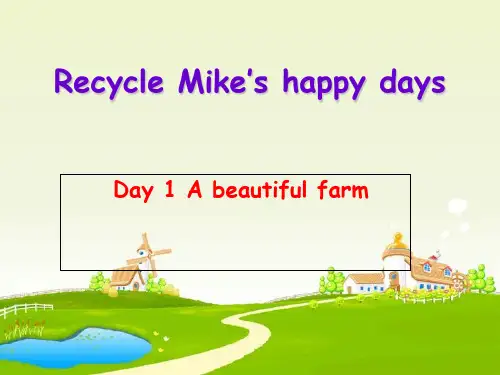
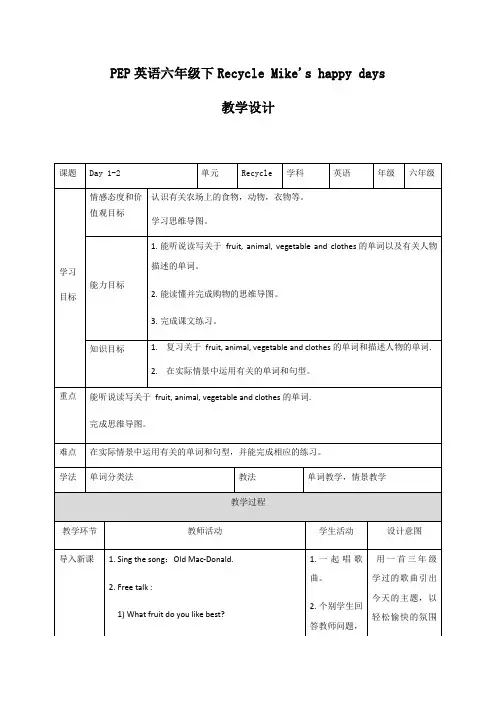
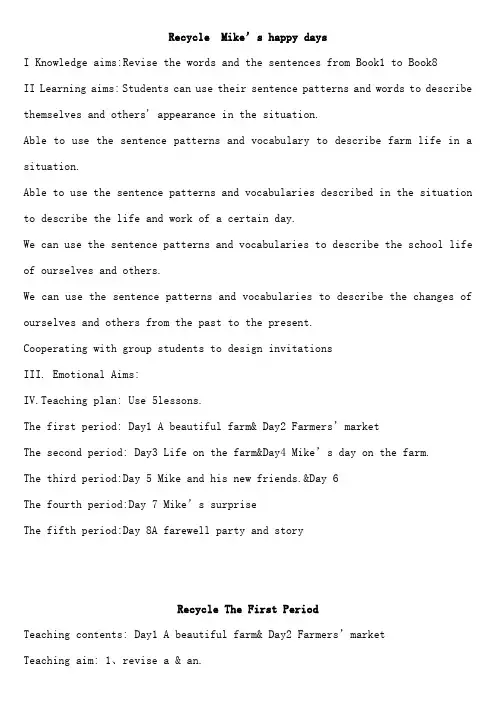
Recycle Mike’s happy daysI Knowledge aims:Revise the words and the sentences from Book1 to Book8II Learning aims:Students can use their sentence patterns and words to describe themselves and others' appearance in the situation.Able to use the sentence patterns and vocabulary to describe farm life in a situation.Able to use the sentence patterns and vocabularies described in the situation to describe the life and work of a certain day.We can use the sentence patterns and vocabularies to describe the school life of ourselves and others.We can use the sentence patterns and vocabularies to describe the changes of ourselves and others from the past to the present.Cooperating with group students to design invitationsIII. Emotional Aims:IV.Teaching plan: Use 5lessons.The first period: Day1 A beautiful farm& Day2 Farmers’marketThe second period: Day3 Life on the farm&Day4 Mike’s day on the farm.The third period:Day 5 Mike and his new friends.&Day 6The fourth period:Day 7 Mike’s surpriseThe fifth period:Day 8A farewell party and storyRecycle The First PeriodTeaching contents: Day1 A beautiful farm& Day2 Farmers’marketTeaching aim: 1、revise a & an.2、Can classified the words.3、Can use time adverbial and bearing adverbial.4、Revise the phrases .5、Can use the adj words to describe the people.III.Teaching key points:1、Revise noun and2、Review and consolidate the asking time, location, price, traffic mode and so on.IV.Teaching difficulties:Use the past time words to make sentences.V.Teaching aids:The PPT and the Multi-Media.VI:.Teaching procedure:StepI Warm upFree talk.Step2 Preview:Where did you go /visit on your holiday? I went to/visitedon my holiday.StepII presentationShow out the pictures to talk.Mike had an 8-day holiday on a farm.Do you think he had a good time there?Were there anything interesting?Now,Let’s open the book.What can you see on the farm?I can see some sheep on the farm.What are they doing?They are eating the grass.What can you see on the farm?I can see some cows and horses on the farm.What else can you see?I can see an umbrella and some fruits.StepIIIconsolidation and extension1、 Shopping active. Talk in groups.2、 Make the new friends.StepIV Homework1、Revise the knowledge what we learn.2、Repare the knowledge will learn.Teaching reflection:Remind students to specify the time, place, person, mode of transportation, purchase items and price.Recycle The Second PeriodI.Teaching contents: Day3 Life on the farm&Day4 Mike’s day on the farm.II.Teaching aim: Combined with the book links, we can review the knowledge about location, travel mode, price, location, time and figure.III.Teaching key points: Able to use the sentence patterns and vocabulary to describe farm life in a situation.IV.Teaching difficulties:Can understand and use the sentences in the dialogue. V.Teaching aids: The PPT and the Multi-Media.VI:.Teaching procedure:Step 1.Warm-upWarm-up:dance the rabbit dancing.Step 2. Presentation1. Think and say.Show out a picture of a farm.Talk about it.This is a farm. Do you know what people usually do on the farm?2. Circle the words in the puzzles.Mike is at this farm.What do people usually do on the farm? Circ le the words in the puzzle.Write down what he,she or they do every day.Bill,Bill’s mother and other people are on the farm.Day 4 Mike’s day on the farm4. Think and do.Step 3. Practice1.Look and say.Show out the picture and learn to talk.2. Try to finish the table.Step 4.Production1. Oral activite.2. Do surey.What are they doing?Please talk about the picture.Step 5. Homework :Copy the senteces.Teaching reflection:Recycle The third PeriodI.Teaching contents: Day3 Life on the farm&Day4 Mike’s day on the farm.II.Teaching aim: Able to use the sentence patterns and vocabularies described in the situation to describe the life and work of a certain day.III.Teaching key points: use the sentence patterns and vocabulariesIV.Teaching difficulties: use the sentence patterns and vocabulariesV.Teaching aids: The PPT and the Multi-Media.VI:.Teaching procedure:Step1.Warm-upFree talk.Step2. Presentation1. Mike and Bill become verygood friends .They’re getting to know each other well .Now Mike is telling Bill about his school life.What does he say? Read and answer the question.Question :1) Does Mike go to school from Monday to Friday?2) What classes does Mike have on Monday?3) What does Mike do in different classes?Step3. PracticeT: Bill made a poster to introduce himself to Mike .Let’slook at the poster ,and see what he talked about .look at the poster ,and see what he talked about .2.Listen and find out the mistake.1.Look and say.T: Bill made a poster to introduce himself to Mike .Let’s2.Write a compatation:Mike ‘s school life.RecycleDay 5 Mike and his new friends: Part 1Day 6 Mike and his new friends: Part 21) Does Mike go to school from Monday to Friday?2) What classes does Mike have on Monday?3) What does Mike do in different classes?Step 4. HomeworkRead the tape.Teaching reflection:Recycle The fourth PeriodI.Teaching contents: Day 5 Mike and his new friends.&Day 6II.Teaching aim: We can use the sentence patterns and vocabularies to describe the school life of ourselves and others.III.Teaching key points: use the sentence patterns and vocabulariesIV.Teaching difficulties: use the sentence patterns and vocabulariesV.Teaching aids: The PPT and the Multi-Media.VI:.Teaching procedure:Step1.Warm-upFree talkStep 2. Pro-readinge PPT to show out the invitation.Let them to know Invitation.2.:Read and do the exercise.1)Who is the invitation from?A. The schoolB. A good friendC. A classmate2) What is the invitation about?A.A birthday partyB.A farewell partyC.A meeting Step3. In- reading1.Read and answer the questions.1) Who is the invitation from?2) What is the invitation about?3) Who is going to the party4) What can Mike do at the party?2. Fill in the blanks according to the invitation. Question :A. Who will have a farewell party?B. When will they have the party?C. Where will they have the party?D. What are they going to do at the party?Step4.Post -readingMake a invitation to invite your friends to your birthday party. Step 5. HomeworkRead the tape exactly.Teaching reflection:Recycle The fifth PeriodI.Teaching contents: Day 8A farewell party and storyII.Teaching aim: Cooperating with group students to design invitations III.Teaching key points: design invitationsIV.Teaching difficulties: design invitationsV.Teaching aids: The PPT and the Multi-Media.VI:.Teaching procedure:Step1Warm upSing the phone song.Step 2. Presentation1.Look and say.Show out a picture of the party,talk the things which they see.T: Wu Yifan is at the party, he saw many things.What are they? Let ’s have a look .2.Finish look and match active.3.Say the chant.1)T: Here is a chant about the farewell party.Read the chant and fill in the chart.A farewell partyRead the chant and fill in the chart below.Step 3. PracticeParty PlanStep3 ProductionStory time1.Read the story and answer the quetions Bb writing:Step 5. HomeworkRead the story and retell it.Teaching reflection:。
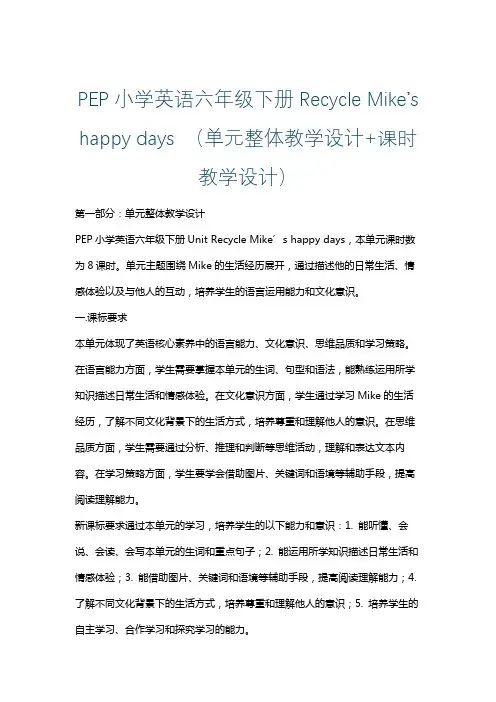
PEP小学英语六年级下册Recycle Mike’s happy days (单元整体教学设计+课时教学设计)第一部分:单元整体教学设计PEP小学英语六年级下册Unit Recycle Mike’s happy days,本单元课时数为8课时。
单元主题围绕Mike的生活经历展开,通过描述他的日常生活、情感体验以及与他人的互动,培养学生的语言运用能力和文化意识。
一.课标要求本单元体现了英语核心素养中的语言能力、文化意识、思维品质和学习策略。
在语言能力方面,学生需要掌握本单元的生词、句型和语法,能熟练运用所学知识描述日常生活和情感体验。
在文化意识方面,学生通过学习Mike的生活经历,了解不同文化背景下的生活方式,培养尊重和理解他人的意识。
在思维品质方面,学生需要通过分析、推理和判断等思维活动,理解和表达文本内容。
在学习策略方面,学生要学会借助图片、关键词和语境等辅助手段,提高阅读理解能力。
新课标要求通过本单元的学习,培养学生的以下能力和意识:1. 能听懂、会说、会读、会写本单元的生词和重点句子;2. 能运用所学知识描述日常生活和情感体验;3. 能借助图片、关键词和语境等辅助手段,提高阅读理解能力;4. 了解不同文化背景下的生活方式,培养尊重和理解他人的意识;5. 培养学生的自主学习、合作学习和探究学习的能力。
二.单元内容分析PEP小学英语六年级下册Unit Recycle Mike’s happy days包括八个课时,分别为:1. Part A Let's learn & Let's do2. Part B Let's learn & Let's do3. Part A Let's spell4. Part B Let's spell5. Part A Let's read & Let's write6. Part B Let's read & Let's write7. Let's check & Let's wrap it up8. Story time1. 第一课时(Part A Let's learn & Let's do):本课时主要学习Mike的日常活动,如游泳、打篮球等,以及相关动词短语。

人教PEP版英语六年级下册《Recycle Mike’s happy days》(Read the chant)教学设计一. 教材分析《Recycle Mike’s happy days》是人教PEP版英语六年级下册的一篇文章,主要讲述了Mike在过去的日子里度过了许多快乐的时光。
通过阅读这篇文章,学生可以了解到一般过去时的用法,以及如何运用动词过去式描述过去发生的事情。
文章内容丰富,插图生动有趣,有助于激发学生的学习兴趣。
二. 学情分析六年级的学生已经掌握了英语学习的基本语法和词汇,具备一定的听、说、读、写能力。
他们对一般过去时有一定的了解,但可能在运用上还存在一定的困难。
此外,学生们的学习兴趣和积极性较高,乐于参与课堂活动。
三. 教学目标1.知识目标:让学生掌握一般过去时的用法,学会用动词过去式描述过去发生的事情。
2.能力目标:提高学生的阅读理解能力,培养学生的英语思维和表达能力。
3.情感目标:培养学生热爱生活、积极向上的心态,学会珍惜过去的美好时光。
四. 教学重难点1.重点:一般过去时的用法,动词过去式的运用。
2.难点:如何运用动词过去式描述具体场景,提高阅读理解能力。
五. 教学方法1.情境教学法:通过设定情境,让学生在实际语境中学习、运用英语。
2.任务型教学法:引导学生参与各种任务,提高学生的实践能力。
3.互动式教学法:鼓励学生积极参与课堂互动,提高课堂氛围。
六. 教学准备1.教材:《人教PEP版英语六年级下册》2.课件:制作与课程内容相关的课件,包括图片、视频等。
3.教学道具:准备与文章内容相关的生活用品,如照片、玩具等。
4.作业布置:提前准备相关的课后练习题,巩固所学知识。
七. 教学过程1.导入(5分钟)利用图片和歌曲引入课题,激发学生的学习兴趣。
展示Mike的照片,引导学生谈论过去的美好时光。
2.呈现(10分钟)老师逐句朗读文章,让学生初步感知文章内容。
朗读过程中,引导学生关注动词过去式的运用。
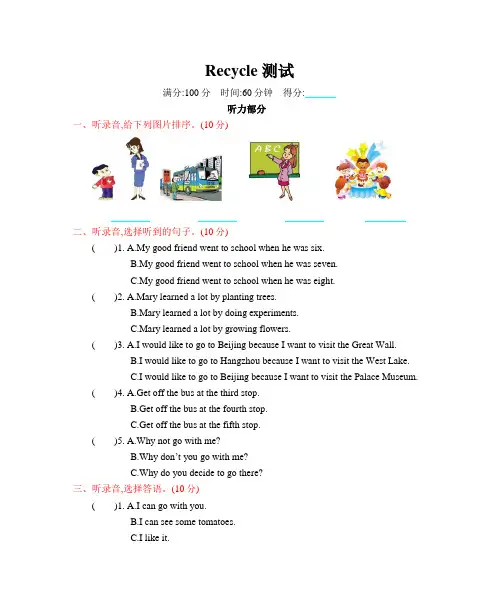
Recycle 测试满分:100分时间:60分钟得分:听力部分一、听录音,给下列图片排序。
(10分)二、听录音,选择听到的句子。
(10分)()1. A.My good friend went to school when he was six.B.My good friend went to school when he was seven.C.My good friend went to school when he was eight.()2. A.Mary learned a lot by planting trees.B.Mary learned a lot by doing experiments.C.Mary learned a lot by growing flowers.()3. A.I would like to go to Beijing because I want to visit the Great Wall.B.I would like to go to Hangzhou because I want to visit the West Lake.C.I would like to go to Beijing because I want to visit the Palace Museum.()4. A.Get off the bus at the third stop.B.Get off the bus at the fourth stop.C.Get off the bus at the fifth stop.()5. A.Why not go with me?B.Why don’t you go with me?C.Why do you decide to go there?三、听录音,选择答语。
(10分)()1. A.I can go with you.B.I can see some tomatoes.C.I like it.()2. A.I go to the supermarket.B.I went to the park.C.On the farm.()3. A.She is a doctor.B.She went swimming.C.She goes to work every day.()4. A.He did. B.He does. C.He do.()5. A.Good luck!B.Have a good trip!C.Bye!笔试部分四、用括号内所给单词的适当形式填空。
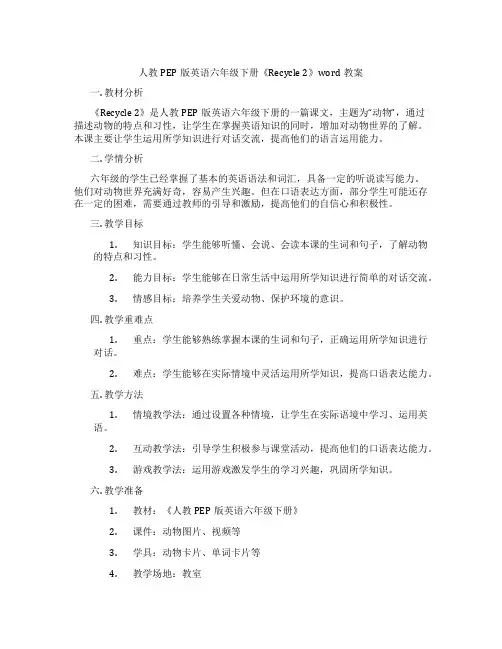
人教PEP版英语六年级下册《Recycle 2》word教案一. 教材分析《Recycle 2》是人教PEP版英语六年级下册的一篇课文,主题为“动物”,通过描述动物的特点和习性,让学生在掌握英语知识的同时,增加对动物世界的了解。
本课主要让学生运用所学知识进行对话交流,提高他们的语言运用能力。
二. 学情分析六年级的学生已经掌握了基本的英语语法和词汇,具备一定的听说读写能力。
他们对动物世界充满好奇,容易产生兴趣。
但在口语表达方面,部分学生可能还存在一定的困难,需要通过教师的引导和激励,提高他们的自信心和积极性。
三. 教学目标1.知识目标:学生能够听懂、会说、会读本课的生词和句子,了解动物的特点和习性。
2.能力目标:学生能够在日常生活中运用所学知识进行简单的对话交流。
3.情感目标:培养学生关爱动物、保护环境的意识。
四. 教学重难点1.重点:学生能够熟练掌握本课的生词和句子,正确运用所学知识进行对话。
2.难点:学生能够在实际情境中灵活运用所学知识,提高口语表达能力。
五. 教学方法1.情境教学法:通过设置各种情境,让学生在实际语境中学习、运用英语。
2.互动教学法:引导学生积极参与课堂活动,提高他们的口语表达能力。
3.游戏教学法:运用游戏激发学生的学习兴趣,巩固所学知识。
六. 教学准备1.教材:《人教PEP版英语六年级下册》2.课件:动物图片、视频等3.学具:动物卡片、单词卡片等4.教学场地:教室七. 教学过程1.导入(5分钟)教师展示各种动物的图片,引导学生说出动物的名称,复习已学的动物词汇。
2.呈现(5分钟)教师播放课文动画视频,让学生初步感知课文内容。
观看结束后,教师提问学生关于动物的特点和习性,引导学生回答。
3.操练(10分钟)教师将学生分成小组,每组选一个动物,用英语描述该动物的特点和习性。
其他小组听后,猜猜是哪种动物。
通过这个活动,让学生熟练掌握本课的生词和句子。
4.巩固(5分钟)教师设计一个动物运动会游戏,让学生在游戏中运用所学知识。
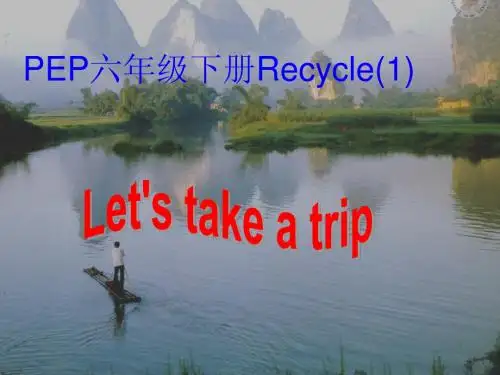
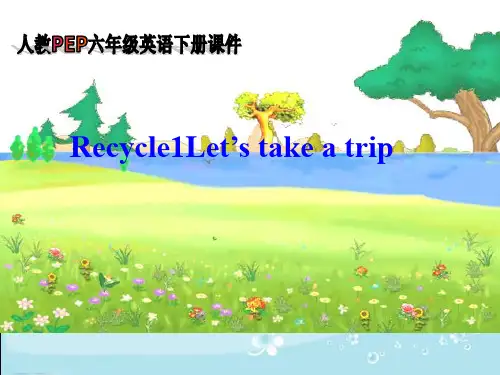
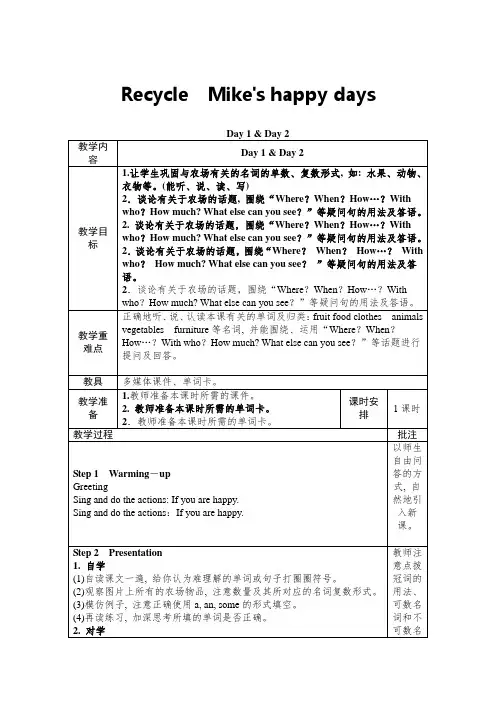
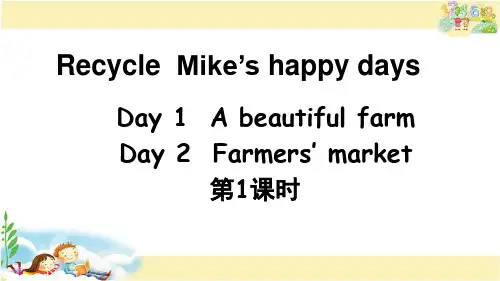
人教版(PEP)小学英语六年级下册 Recycle 知识点总结六下Recycle Day 1 A beautiful farm 知识点1.a,an和some的用法不定冠词a,an和限定词some都可以用来修饰名词。
(1)a意为“意(人、事、物)”,用在以辅音音素开头的可数名词单数前。
(辅用a)(2)an意为“意(人、事、物)”,用在以元音音素开头的可数名词单数前。
(元用an)(3)some意为“一些”,既可以修饰可数名词复数又可以修饰不可数名词。
(some+可数名词复数/不可数名词)小学阶段,与不定冠词an搭配的常见名词有:eraser橡皮,ear耳朵,eye眼睛,arm胳膊,elephant大象,ant蚂蚁,egg鸡蛋,onion洋葱,orange橙子,apple苹果,aunt姑母,uncle姑父,animal动物,idea想法,island岛,umbrella雨伞注意:若名词前有形容词修饰时,若形容词的读音以辅音音素开头,则要用a,如a good boy一个好男孩。
若形容词的读音以元音音素开头,则要用an,如an easy thing一件容易的事。
2.名词的数名词是表示人、物、地点以及抽象感念的词,分为可数名词和不可数名词。
可数名词有单数和复数两种形式。
可数名词变复数的规则变化:(1)一般情况词尾加s,词尾发音/s/或/z/,如desk-desks书桌(2)以s,x,sh,ch结尾词尾加es,词尾发音/IZ/,如fox-foxes狐狸(3)以“辅音字母+y”结尾的词,变y为i再加es,词尾发音/IZ/,如candy-candies糖果(4)以f或fe结尾的词,变f或fe为v,再加es,词尾发音/vz/,如knife-knives刀(5)以o结尾有生命的词在词尾加es,词尾发音/z/,如hero-heroes英雄,tomato-tomatoes西红柿,potato-potatoes土豆口诀:英雄(hero)爱吃西红柿(tomato)和土豆(potato)(6)以o结尾无生命的词在词尾加s,词尾发音/z/,如photo-photos,radio-radios收音机Day 2 Farmer’s market 知识点1.反义词归纳:(1)表示动作的词:come来—go去,open开—close关,cry哭—laugh笑,star开始—stop停止,buy买—sell卖,borrow借来—return归还,push推—pull拉,take拿走—bring带来,fall落下—rise升起,ask问—answer答,love爱—hate恨,teach教—learn学习,lose丢失—find找到,forget忘记—remember记住(2)形容体貌的词:fat胖的—thin瘦的,beautiful美丽的—ugly丑陋的,tall高的—short矮的,light轻的—heavy重的,young年轻的—old年老的,long长的—short短的,strong强壮的—weak虚弱的(3)表示方位的词:east东—west西,south南—north北,up向上—down向下,front前面—back后面,inside在里面—outside在外面,in里面—out外面,over在...上面—under在...下面(4)其他:cold冷的—hot热的,cool凉爽的—warm暖和的,hard硬的—soft软的, clean干净的—dirty脏的,new新的—old旧的,poor穷的—rich富的,dark黑色的—bright明亮的,black黑色的—white白色的,good好的—bad坏的,happy高兴地—sad悲伤的,far远的—near近的,clever聪明的—stupid笨的,late晚的—early早的,free空闲的—busy忙碌的,right对的—wrong错的, more更多的—less更少的,dry干的—wet湿的,active活泼的—quiet安静的2.特殊疑问词:what什么,询问内容:What did you do last night?你昨天晚上做什么了?when什么时候,询问时间:When do you get up?你什么时候起床?where在哪里,询问地点:Where is my pen?我的钢笔在哪里?who谁,询问人:Who did you go with?你和谁一起去的?--My parents.我的父母。
人教PEP版英语六年级下册《Recycle Mike’s happy days》(Story time)说课稿一. 教材分析《Recycle Mike’s happy days》是人教PEP版英语六年级下册的一篇故事课。
本课主要讲述了Mike在垃圾回收站度过的一天,通过他的经历,让学生了解垃圾回收的重要性,以及如何进行垃圾分类。
故事内容贴近学生的生活,富有教育意义。
二. 学情分析六年级的学生已经具备了一定的英语基础,对于故事情节的理解和角色扮演等活动能够积极参与。
但部分学生对于垃圾分类的常识还不够了解,需要在教学中进行引导和渗透。
三. 说教学目标1.知识目标:学生能够听懂、会说、会读故事中的核心词汇和句子,如“recycle”、“garbage”、“sort”等。
2.能力目标:学生能够运用所学词汇和句型,简单描述垃圾回收的过程。
3.情感目标:学生能够认识到垃圾回收的重要性,学会垃圾分类的常识。
四. 说教学重难点1.重点:故事中核心词汇和句型的学习。
2.难点:垃圾分类的常识和垃圾回收过程的描述。
五. 说教学方法与手段1.情景教学法:通过设置故事情境,让学生在真实的环境中学习英语。
2.任务型教学法:引导学生参与垃圾分类的实际操作,提高学生的实践能力。
3.小组合作学习:鼓励学生分组讨论,培养学生的团队协作能力。
六. 说教学过程1.导入:教师通过提问,引导学生谈论日常生活中的垃圾处理问题,激发学生的学习兴趣。
2.呈现:教师播放故事动画,让学生整体感知故事内容。
3.理解:教师带领学生逐句理解故事,讲解核心词汇和句型。
4.实践:教师学生进行垃圾分类游戏,让学生在实践中学会垃圾分类。
5.巩固:教师引导学生进行小组讨论,用英语描述垃圾回收的过程。
6.拓展:教师引导学生思考垃圾回收的意义,提出环保的建议。
7.总结:教师对本课内容进行总结,强调垃圾分类的重要性。
七. 说板书设计板书设计要简洁明了,突出重点。
可以设计成一幅垃圾回收的流程图,包含关键词“recycle”、“garbage”、“sort”等。
新版PEP六年级英语下册Recycle表格教案Recycle Mike’s happy days第一课时年级六年级授课时间课型复习课课题RecycleDay 1 A beautifulfarm课时安排共9课时第1课时主备人复备人目标依据1.课程标准相关要求能理解朗诵课文内容,并完成相应练习;能掌握动词过去式的变化方法;2.教材分析本单元是一个综合复习单元,有明确的主题:Mike的农庄之旅。
教材围绕这个主题,根据故事线的发展,呈现了一系列丰富的情景和充满真实实际意义的任务型活动。
教材以Mike在农庄八天的游玩为主要话题展开,设计了一系列情景对话和任务型活动,形式包括阅读理解、听力练习、游戏和写作任务。
3.学情分析设计活动时,必须创设一定的情景,特别符合小学生生活经历的情景,使活动生活化。
让学生在富有生活气息的活动中学习英语,其兴趣会更加强烈,还可以用表演简单的英文课本剧等愉快的教学方法来活跃课堂气氛。
激发学生的学习兴趣。
学习目标1、复习冠词a和an的用法区别。
2、能分辨单词的词性和所属范畴,会给单词分类。
3、掌握常见的时间状语和地点状语。
4、复习购物的交际用语和常见的表达方式。
5、会用形容词描述自己或他人的外部特征及个性特征。
评价任务1、创设真实语言情景,采取多种形式操练重点句型,突破重点。
2、运用所学过的动词短语来进行替换练习。
学习重点1、复习所学名词和形容词的用法。
2、复习、巩固有关询问时间、地点、价格、交通方式等。
学习难点1、掌握所学知识在实际情景中的灵活运用。
2、提升学生的语言表达能力。
教法学法讨论法,游戏法课前准备多媒体课件卡片图片教学过程学法指导一、课前热身(warm-up)打招呼。
Good morning/Hello/Good afternoon,boys and girls. Good morning/Hello/Good afternoon,teacher. Welcome back to our class.How are you today? Fine,thank you.二、课前预习(preview)1.检查作业,检测学生对上一单元所学知识的掌握情况。
2.学生同桌之间相互询问对方的旅游经历。
如:Where did you go /visit on your holiday?I went to/visited…on my holiday.三、新课呈现(presentation)1、看图说话。
接上面的对话,教师说:Mike had an 8-day holiday on a farm.Do you think he had a good time there?Were there anything interesting?Now,Let’s open the book.教师出示课本第一幅挂图,让学生仔细观察图上都有什么东西,标出相应的英语单词。
然后教师指名学生逐一回答问题。
What can you see on the farm?I can see some sheep on the farm.What are they doing?They are eating the grass.What can you see on the farm?I can see some cows and horses on the farm. What else can you see?I can see an umbrella and some fruits.指名学生到黑板上罗列出每个物品的名称。
然后,请学生数出每种物品的数量,在名词前面加上冠词或数量词。
提醒学生注意区分冠词a和an的用法区别。
2、单词归类。
请学生仔细观察课本上的五组单词,仿照第一组的例子,给剩下四组单词归类,并给每组再添上几个合适的单词。
学生自主完成,教师巡视。
最后,全班集体交流,核对答案。
四、巩固与延伸(consolidation and extension)1、购物活动。
学生分小组讨论,提醒学生要明确购物的时间、地点、人物、交通方式、所购物品及价格预算。
稍后,请各小组以角色扮演的形式讨论结果。
2、结识新朋友。
首先让学生看方框中罗列的词,写出与每个词或词组相反或相对应的词或词组。
学生独立完成,然后集体核对答案。
然后,让学生参照图片上的例句,仿写句子。
给学生足够时间进行操练,教师巡视指导。
五、课堂小结。
(summary)师生一起总结本节课所学的词汇和句型。
作业布置1、复习本节课所学知识。
2、预习下节课要学的内容。
板书设计RecycleDay 1 A beautiful farmFruit apple orangeFood egg cakeAnimal horse cowClothes jacket shoesVegetables tomato potato教学反思第二课时年级六年级授课时间课型复习课课题RecycleDay 2Farmers’market课时安排共9课时第2课时主备人aaa复备人aaa目标依据1.课程标准相关要求同学们掌握一般现在时和一般过去时的用法,提升学生的语言交际能力。
4.教材分析本单元是一个综合复习单元,有明确的主题:Mike的农庄之旅。
教材围绕这个主题,根据故事线的发展,呈现了一系列丰富的情景和充满真实实际意义的任务型活动。
教材以Mike 在农庄八天的游玩为主要话题展开,设计了一系列情景对话和任务型活动,形式包括阅读理解、听力练习、游戏和写作任务。
5.学情分析设计活动时,必须创设一定的情景,特别符合小学生生活经历的情景,使活动生活化。
让学生在富有生活气息的活动中学习英语,其兴趣会更加强烈,还可以用表演简单的英文课本剧等愉快的教学方法来活跃课堂气氛。
激发学生的学习兴趣。
学习目标1、能结合书上的联系综合复习回顾有关方位、出行方式、价格、地点、时间、人物外貌等方面的知识点。
2、能完成相关练习。
3、能制作思维导图。
评价任务学习目标在复习环节呈现。
学习重点能结合书上的联系综合复习回顾有关方位、出行方式、价格、地点、时间、人物外貌等方面的知识点。
学习难点能制作思维导图。
教法学法讨论法,游戏法课前准备多媒体课件卡片图片教学过程学法指导三、课前热身(warm-up)1教师出示城市导图,师生进行问答练习,如:T: Where is the park ?S: It’s near the zoo.T: Where is the library ?S: It’s next to the post office.T: Where is the supermarket ?S: It’s... ...... ...T: Is there a museum ?S: Yes ,there is .T: Is there a zoo ?S: Yes ,there is .T: Is there a hospital ?S: No ,there isn’t .2 教师说指令,学生做动作。
T:Turn left.T:Turn right.T:Go straignt .T:Stop and wait at a red light .T:slow down and atop at a yellow light .T:Go at a green light .3 师生说唱内容如下:How can I get to the cinema ?Turn left at the bookstore .How do you go to school ?Sometimes by busSometimes on foot... ...4 师生会话T: Look at my beautiful new shoes .S: Hw much are they ?T: Are they 100 yuan ?S: No ,they are 120 yuan .T: What time is it ?S: ... ...三、新课呈现(presentation)Day 2 Farmers’ market1 T:Bill want to go shopping .If you are Bill ,what would you thinkAbout ?S:When should I go ? Who should I go with ?T:OK .I hear somebody says “When”What day is it today ?S:It’s Monday .... ...教师根据学生的回答,在黑板上画出思维导视图。
注意以引导学生说为主,并引导学生以where ,when 等词进行思维发散。
教师做适当提示,不断完善思维导图。
每涉及一方面的内容,教师注意引导学生进行发散练习。
如:when,教师可引导学生回顾日期、星期、时刻等方面的表达方式及询问方式。
完成思维导图,师生一起总结,并过一遍思维导图。
2 学生搭档一起合作,制作一份新的思维导图,并以小组为单位进行展示。
3 教师口头描述某个人的外貌特征,并在黑板上画出简笔画,请学生猜一猜是谁,然后老师问:T:What am I like ?S:You are tall and thin .学生完成43页练习,学生进行自由描述。
四练习1 学生之间自由介绍自己的一位朋友的外貌特征。
2 教师出示问句或答句,学生回答出相应的问句或答句。
五、巩固与延伸(consolidation and extension)1 学生自己设计思维导图2 做活动的配套手册。
六、课堂小结。
师生一起总结本节课所学的词汇和句型。
作业布置1、复习、巩固本节课所学的知识点。
2、预习下节课要学的内容。
板书设计RecycleWhere library supermarket When moring afternoon How much ...教学反思第三课时年级六年级授课时间课型复习课课题RecycleDay 3 life on thefarm课时安排共9课时第3课时主备人复备人目标依据1.课程标准相关要求同学们掌握一般现在时、现在进行时、和一般过去时的用法,提升学生的语言交际能力。
6.教材分析本单元是一个综合复习单元,有明确的主题:Mike的农庄之旅。
教材围绕这个主题,根据故事线的发展,呈现了一系列丰富的情景和充满真实实际意义的任务型活动。
教材以Mike 在农庄八天的游玩为主要话题展开,设计了一系列情景对话和任务型活动,形式包括阅读理解、听力练习、游戏和写作任务。
7.学情分析设计活动时,必须创设一定的情景,特别符合小学生生活经历的情景,使活动生活化。
让学生在富有生活气息的活动中学习英语,其兴趣会更加强烈,还可以用表演简单的英文课本剧等愉快的教学方法来活跃课堂气氛。